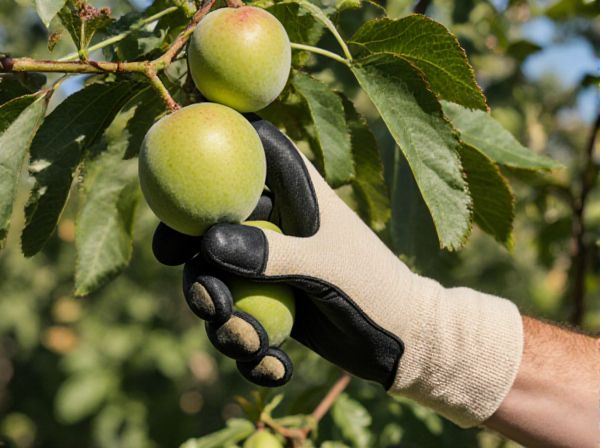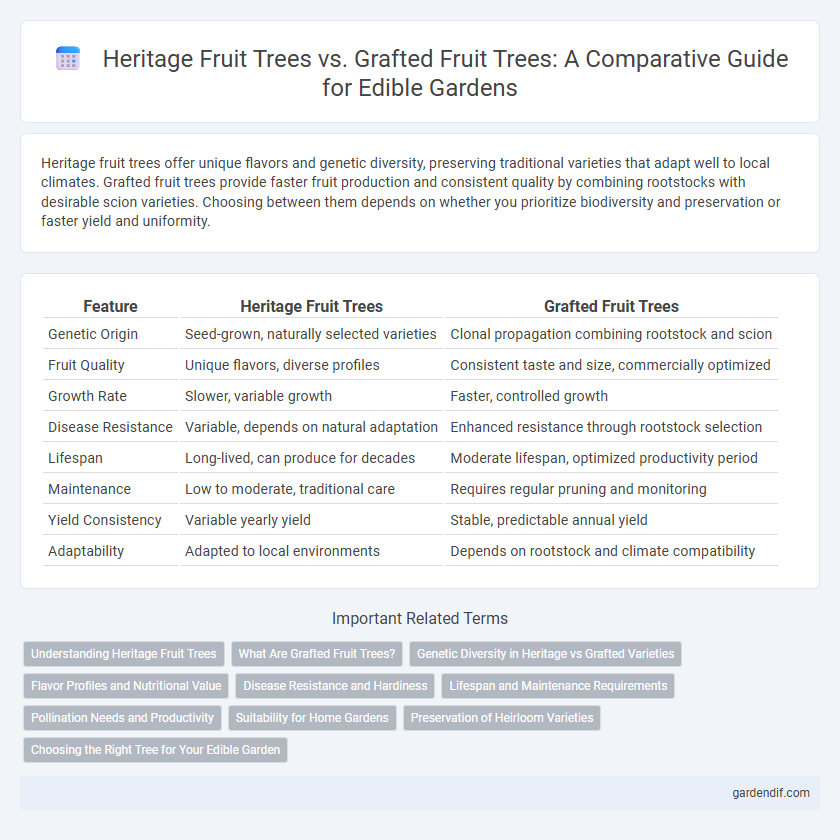
Heritage fruit trees vs Grafted fruit trees Illustration
Heritage fruit trees offer unique flavors and genetic diversity, preserving traditional varieties that adapt well to local climates. Grafted fruit trees provide faster fruit production and consistent quality by combining rootstocks with desirable scion varieties. Choosing between them depends on whether you prioritize biodiversity and preservation or faster yield and uniformity.
Table of Comparison
| Feature | Heritage Fruit Trees | Grafted Fruit Trees |
|---|---|---|
| Genetic Origin | Seed-grown, naturally selected varieties | Clonal propagation combining rootstock and scion |
| Fruit Quality | Unique flavors, diverse profiles | Consistent taste and size, commercially optimized |
| Growth Rate | Slower, variable growth | Faster, controlled growth |
| Disease Resistance | Variable, depends on natural adaptation | Enhanced resistance through rootstock selection |
| Lifespan | Long-lived, can produce for decades | Moderate lifespan, optimized productivity period |
| Maintenance | Low to moderate, traditional care | Requires regular pruning and monitoring |
| Yield Consistency | Variable yearly yield | Stable, predictable annual yield |
| Adaptability | Adapted to local environments | Depends on rootstock and climate compatibility |
Understanding Heritage Fruit Trees
Heritage fruit trees, also known as heirloom varieties, are grown from seeds passed down through generations and maintain genetic diversity, often resulting in unique flavors and resilient growth. Unlike grafted fruit trees, which are propagated by joining a scion to rootstock for uniformity and faster fruit production, heritage trees grow true to seed and adapt better to their local environment. Understanding heritage fruit trees helps preserve biodiversity, supports sustainable agriculture, and offers distinctive fruit characteristics that are often lost in commercial grafted varieties.
What Are Grafted Fruit Trees?
Grafted fruit trees are created by joining the tissue of two different plants to combine the rootstock's hardy root system with the desired fruit-producing variety, enhancing disease resistance and fruit quality. This technique allows growers to produce consistent, high-yield crops with improved growth rates compared to heritage fruit trees, which grow naturally from seed and retain genetic variation. Grafting is widely used in commercial orchards to optimize fruit production, control tree size, and ensure uniformity.
Genetic Diversity in Heritage vs Grafted Varieties
Heritage fruit trees maintain greater genetic diversity due to their open-pollinated nature and adaptation to local environments over centuries, preserving unique traits and flavors. Grafted fruit trees often rely on clones of select cultivars, resulting in limited genetic variation and increased vulnerability to pests and diseases. This genetic uniformity in grafted varieties can compromise long-term resilience compared to the robust genetic pool found in heritage varieties.
Flavor Profiles and Nutritional Value
Heritage fruit trees produce fruits with complex, rich flavor profiles often prized for their unique taste nuances and higher antioxidant content compared to grafted varieties. Grafted fruit trees, bred for consistency and durability, may yield fruits with more uniform size and sweetness but can lack the depth of flavor and nutritional density found in heritage types. The nutrient density in heritage fruits is frequently enhanced by their adaptation to local soil and climate conditions, promoting greater vitamin retention and diverse phytochemical presence.
Disease Resistance and Hardiness
Heritage fruit trees exhibit strong disease resistance and exceptional hardiness due to their genetic diversity and adaptation to local climates over generations. Grafted fruit trees, while offering faster fruit production and desired traits, often have weaker disease resistance as rootstocks may be susceptible to certain pathogens. Selection of disease-resistant rootstocks in grafted trees can enhance hardiness, but heritage varieties generally provide more robust long-term resilience.
Lifespan and Maintenance Requirements
Heritage fruit trees often have longer lifespans, sometimes exceeding 50 years, due to their deep root systems and natural resilience, requiring minimal maintenance beyond standard pruning and pest control. Grafted fruit trees generally have shorter lifespans, typically 15 to 25 years, and demand more intensive care such as regular fertilization, graft union monitoring, and disease prevention to maintain productivity. The choice between heritage and grafted trees significantly impacts long-term orchard management strategies and yields.
Pollination Needs and Productivity
Heritage fruit trees typically require cross-pollination from other compatible varieties to achieve optimal fruit set, relying on local pollinators like bees, which can sometimes limit productivity in isolated plantings. Grafted fruit trees often combine rootstocks and scions selected for improved self-pollination capabilities and higher fruit yield, enhancing overall orchard productivity even in limited pollinator environments. Understanding pollination needs is crucial for maximizing fruit production, with grafted trees generally offering more consistent yields compared to heritage varieties.
Suitability for Home Gardens
Heritage fruit trees are well-suited for home gardens due to their adaptability to local climates and resistance to pests, providing diverse flavors and genetic variety. Grafted fruit trees offer faster fruit production and uniform quality, making them ideal for gardeners seeking quick yields and consistent harvests. Choosing between heritage and grafted trees depends on the gardener's preference for traditional resilience versus commercial traits.
Preservation of Heirloom Varieties
Heritage fruit trees play a crucial role in the preservation of heirloom varieties by maintaining genetic diversity and unique flavors that are often lost in grafted fruit trees designed for mass production. These traditional trees, grown from seeds or cuttings, ensure the survival of rare cultivars adapted to specific local climates and soils. Grafted fruit trees, while providing consistency and disease resistance, often prioritize uniformity over genetic variety, making heritage trees essential for conserving biodiversity in edible landscapes.
Choosing the Right Tree for Your Edible Garden
Heritage fruit trees offer unique flavors and genetic diversity, often thriving in local climate conditions without intensive care. Grafted fruit trees provide consistent fruit quality and earlier yields by combining rootstock vigor with desirable scion traits, making them ideal for controlled garden environments. Selecting the right tree depends on balancing the desire for biodiversity and traditional flavors with the need for reliable production and disease resistance in your edible garden.
Heritage fruit trees vs Grafted fruit trees Infographic

 gardendif.com
gardendif.com